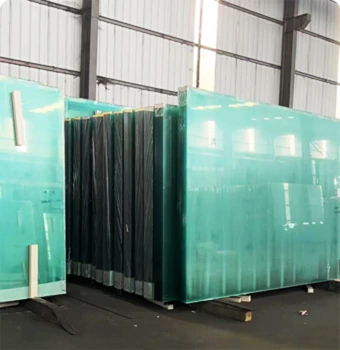The Production of Tempered Glass A Comprehensive Overview
Tempered glass, also known as toughened glass, has become a staple in various industries due to its superior strength and safety features. The production process of tempered glass involves a series of precise steps that transform ordinary glass into a durable material capable of withstanding high temperatures and significant impact.
Step 1 Raw Material Preparation
The journey to producing tempered glass begins with the selection and preparation of raw materials. The primary component is silica sand, which must be of high purity to ensure the quality of the final product. Additional materials, such as soda ash and limestone, are mixed with silica to improve its melting properties. This mixture is then heated in a furnace at approximately 1,600 degrees Celsius, causing it to melt and form molten glass.
Step 2 Forming the Glass
Once the molten glass is ready, it is shaped into sheets or specific dimensions depending on the intended use. This can be achieved through various methods, including floating (for flat glass) or pressing and blowing techniques for specialized shapes. The forming process must be carefully controlled to ensure uniform thickness and clear transparency, which are critical qualities for tempered glass.
Step 3 Annealing
tempered glass production
After the glass has been formed, it undergoes a process called annealing, where it is gradually cooled in a controlled environment. This cooling process alleviates internal stresses that may have developed during shaping and ensures the glass has uniform thickness. If this stage is skipped or improperly conducted, the glass may become prone to shattering during the tempering phase or when subjected to sudden temperature changes.
Step 4 Tempering Process
The actual tempering of glass involves heating the annealed glass to temperatures ranging between 600 to 700 degrees Celsius, followed by rapid cooling through a process known as quenching. This thermal shock treatment significantly increases the strength of the glass, making it approximately five to seven times stronger than non-tempered glass. During quenching, the outer surfaces of the glass cool quickly while the inner part remains hotter for longer, creating a state of compressive stress on the surface and tensile stress within the core.
Step 5 Quality Control and Testing
Quality assurance is critical in the production of tempered glass. Each batch undergoes rigorous testing to check for visual defects, strength, and resistance to thermal stress. Additionally, tools and techniques such as the “breakage test” are employed to ensure the glass can shatter into small, blunt pieces when broken, reducing the risk of injury.
Conclusion
The production of tempered glass is a complex yet fascinating process, blending science and engineering to develop a material that meets the demands of safety and performance. From its raw materials to the final quality checks, each step is vital in ensuring that tempered glass delivers its renowned durability and aesthetic appeal across a variety of applications, including architectural designs, automotive manufacturing, and consumer products. As technology advances, we can expect further innovations in tempered glass production, further enhancing its capabilities and expanding its applications.
 Afrikaans
Afrikaans  Albanian
Albanian  Amharic
Amharic  Arabic
Arabic  Armenian
Armenian  Azerbaijani
Azerbaijani  Basque
Basque  Belarusian
Belarusian  Bengali
Bengali  Bosnian
Bosnian  Bulgarian
Bulgarian  Catalan
Catalan  Cebuano
Cebuano  Corsican
Corsican  Croatian
Croatian  Czech
Czech  Danish
Danish  Dutch
Dutch  English
English  Esperanto
Esperanto  Estonian
Estonian  Finnish
Finnish  French
French  Frisian
Frisian  Galician
Galician  Georgian
Georgian  German
German  Greek
Greek  Gujarati
Gujarati  Haitian Creole
Haitian Creole  hausa
hausa  hawaiian
hawaiian  Hebrew
Hebrew  Hindi
Hindi  Miao
Miao  Hungarian
Hungarian  Icelandic
Icelandic  igbo
igbo  Indonesian
Indonesian  irish
irish  Italian
Italian  Japanese
Japanese  Javanese
Javanese  Kannada
Kannada  kazakh
kazakh  Khmer
Khmer  Rwandese
Rwandese  Korean
Korean  Kurdish
Kurdish  Kyrgyz
Kyrgyz  Lao
Lao  Latin
Latin  Latvian
Latvian  Lithuanian
Lithuanian  Luxembourgish
Luxembourgish  Macedonian
Macedonian  Malgashi
Malgashi  Malay
Malay  Malayalam
Malayalam  Maltese
Maltese  Maori
Maori  Marathi
Marathi  Mongolian
Mongolian  Myanmar
Myanmar  Nepali
Nepali  Norwegian
Norwegian  Norwegian
Norwegian  Occitan
Occitan  Pashto
Pashto  Persian
Persian  Polish
Polish  Portuguese
Portuguese  Punjabi
Punjabi  Romanian
Romanian  Russian
Russian  Samoan
Samoan  Scottish Gaelic
Scottish Gaelic  Serbian
Serbian  Sesotho
Sesotho  Shona
Shona  Sindhi
Sindhi  Sinhala
Sinhala  Slovak
Slovak  Slovenian
Slovenian  Somali
Somali  Spanish
Spanish  Sundanese
Sundanese  Swahili
Swahili  Swedish
Swedish  Tagalog
Tagalog  Tajik
Tajik  Tamil
Tamil  Tatar
Tatar  Telugu
Telugu  Thai
Thai  Turkish
Turkish  Turkmen
Turkmen  Ukrainian
Ukrainian  Urdu
Urdu  Uighur
Uighur  Uzbek
Uzbek  Vietnamese
Vietnamese  Welsh
Welsh  Bantu
Bantu  Yiddish
Yiddish  Yoruba
Yoruba  Zulu
Zulu 

